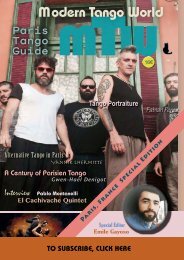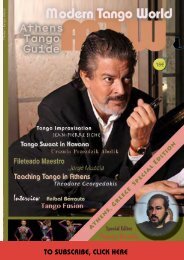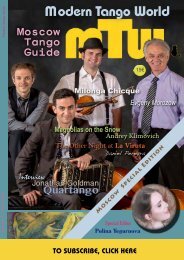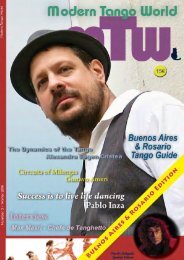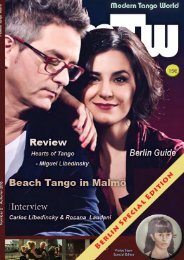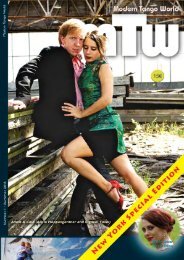Modern Tango World #7 (Havana & the Caribbean)
Caribbean Special Features Tango in the Crystal Isles Percell St. Thomas & Raymond Lauzzana 03 Tango Cubano Maria Roumpalou 08 Tango on the Costa Caribe Raymond Lauzzana 12 Cruising the Caribe Percell St. Thomass 14 Guide to Tango in the Caribbean 18 Cuba’s Special Painter Pedro Álvarez Castelló 24 Interview with Martin Delgado Marco Buso 28 Top Ten Ways to Get Asked to Dance Karen Kaye 32 100 Years of Recorded Tango Raymond Lauzzana 34 New Tango Music Arndt Büssing 38 Tango Moves: Promenades (Paseos) Raymond Lauzzana 42 Letters to the Editor 46
Caribbean Special Features
Tango in the Crystal Isles Percell St. Thomas & Raymond Lauzzana 03
Tango Cubano Maria Roumpalou 08
Tango on the Costa Caribe Raymond Lauzzana 12
Cruising the Caribe Percell St. Thomass 14
Guide to Tango in the Caribbean 18
Cuba’s Special Painter Pedro Álvarez Castelló 24
Interview with Martin Delgado Marco Buso 28
Top Ten Ways to Get Asked to Dance Karen Kaye 32
100 Years of Recorded Tango Raymond Lauzzana 34
New Tango Music Arndt Büssing 38
Tango Moves: Promenades (Paseos) Raymond Lauzzana 42
Letters to the Editor 46
Create successful ePaper yourself
Turn your PDF publications into a flip-book with our unique Google optimized e-Paper software.
100 Years of Recorded <strong>Tango</strong><br />
Raymond Lauzzana<br />
2017 marks <strong>the</strong> 100th anniversary of recorded tango. Roberto Firpo’s La Cumparsita was <strong>the</strong> <strong>the</strong><br />
first recording of a tango that was ever made. It was recorded in November of 2016 at <strong>the</strong> studio of<br />
Max Glücksmann in Buenos Aires. for Odeon Records. The record was released to <strong>the</strong> public in a<br />
performance at <strong>the</strong> café La Giralda in Montevideo where Firpo frequently performed.<br />
La Cumparsita was originally written as a march. It<br />
was composed by an 18-year-old architecture student<br />
named Gerardo Hernán Becho Matos Rodríguez.. Early<br />
in 1916, he showed <strong>the</strong> song to orchestra leader Roberto<br />
Firpo. When Firpo looked at <strong>the</strong> music, he saw ita as<br />
a tango. Originally, <strong>the</strong> song had two parts. Firpo added<br />
a third part taken from his earlier tangos — La gaucha<br />
Manuela and Curda Completa. He also added parts of<br />
Giuseppe Verdi’s Miserere from <strong>the</strong> opera Il trovatore.<br />
Although it was among <strong>the</strong> few tango recordinsg, it<br />
did not gain much popularity until lyrics were added<br />
in 1924 by <strong>the</strong> Argentine Pascual Contursi. The song<br />
soon became an international hit, and is considered <strong>the</strong><br />
most widely known tango song in <strong>the</strong> world.<br />
It is also <strong>the</strong> most widely recorded tango song of all time.<br />
It has been performed and recorded by small trios and<br />
large bands everywhere in <strong>the</strong> world. Having moved to<br />
Paris, Matos Rodríguez spent <strong>the</strong> nearly two decades in<br />
various court battles over royalties, finally succeeding in<br />
secure title to <strong>the</strong> rights for La Cumparsita.<br />
This year, <strong>the</strong>re will be major events thoughout Uruguay<br />
celebrating this 100th anniversary. of La Cumparsita.<br />
Montevideo begins <strong>the</strong> celebration with a musical<br />
show in Plaza Independencia with <strong>the</strong> participation of<br />
numerous artists. An open-air event called Bienvenido<br />
Cumparsita, by Intendance, is followed by an event at<br />
<strong>the</strong> Salvo Palace, where <strong>the</strong> La Giralda Café used to be,<br />
where <strong>the</strong> song was first performed.<br />
Performers will include Ricardo Olivera, Valeria Lima,<br />
Maia Castro, Triple Nelson, Gabriel Peluffo, Néstor<br />
Vaz, Laura Legazcue, Roberto Herrera, Monica Navarro<br />
and <strong>the</strong> Philharmonic Orchestra of Montevideo.<br />
Admission to any of <strong>the</strong>se events will be with free and<br />
<strong>the</strong>re will be a fireworks!<br />
Uruguay can rightfully claim that <strong>the</strong> tango was originally<br />
made in Uruguay. Argentines, from <strong>the</strong> o<strong>the</strong>r side<br />
of <strong>the</strong> Rio Plate, surely will claim that that is Argentines<br />
that brought <strong>the</strong> erotic dance to <strong>the</strong> sensual music.<br />
— 36 —<br />
TO SUBSCRIBE, CLICK HERE




